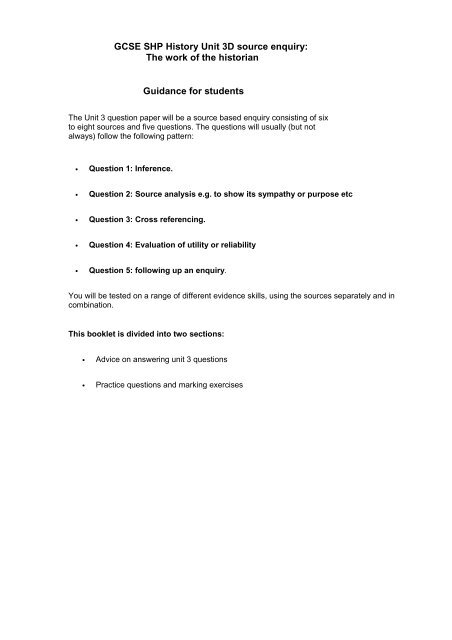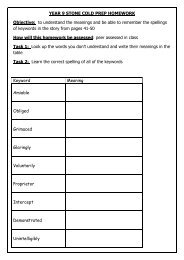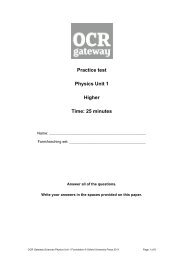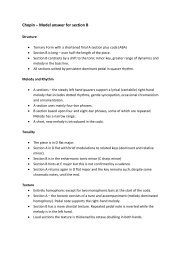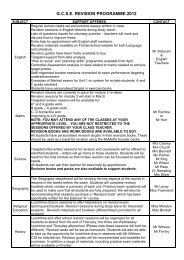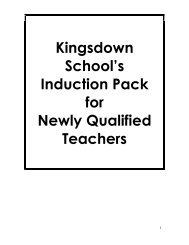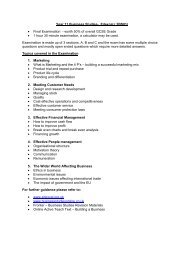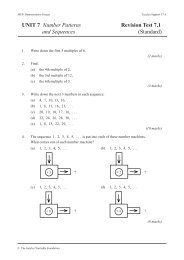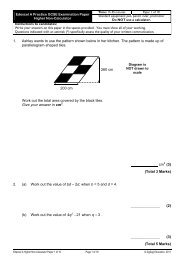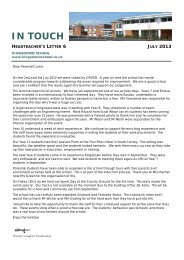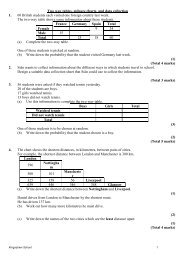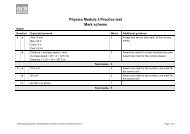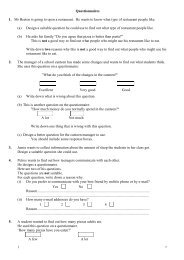Role of the Historian booklet - Kingsdown School
Role of the Historian booklet - Kingsdown School
Role of the Historian booklet - Kingsdown School
You also want an ePaper? Increase the reach of your titles
YUMPU automatically turns print PDFs into web optimized ePapers that Google loves.
Question 1: InferenceThe first question is asking you to make inferences (work something out) from a source.The question requires you to:••Make at least two inferencesUse evidence from <strong>the</strong> source to back up <strong>the</strong> inference.What is an inference?An inference means:Something you can work out from <strong>the</strong> source which is not directly said.For example:••What is <strong>the</strong> source suggesting?What is its attitude or tone? Is <strong>the</strong> writer sarcastic, sad, pleased, angry, happy, supportiveetc? If it‟s a visual source, what do <strong>the</strong> details, expressions etc suggest? What evidencein <strong>the</strong> source supports this attitude, tone, or message?How to answer inference questionsPractice by highlighting words or phrases which suggest inferences as you read asource. [If it‟s a visual source, draw lines out from <strong>the</strong> details which you can use.]Try writing <strong>the</strong> inference and <strong>the</strong>n support it with a word or phrase from <strong>the</strong> source.Remember you need to make two supported inferences to achieve full marks!Exam tip: students <strong>of</strong>ten fail to make inferences and instead copy out or summarise <strong>the</strong> source.You need to use phrases such as “You can work out that…” or “this shows that…”
Question type 4How can you tell that <strong>the</strong> author / artist was sympa<strong>the</strong>tic to …?How can you tell that <strong>the</strong> artist author was against …..?What you need to work outThis question gives you <strong>the</strong> author‟s attitude and asks you how you can tell this from <strong>the</strong> detailsand message <strong>of</strong> <strong>the</strong> source.All <strong>the</strong>se questions require two things:Awareness that <strong>the</strong> sources were created with a purpose.Analysis <strong>of</strong> <strong>the</strong> details in <strong>the</strong> source to show what <strong>the</strong> author / artist was trying tomake you think.What is meant by <strong>the</strong> purpose <strong>of</strong> a source?This means why was <strong>the</strong> source produced? What is <strong>the</strong> source trying to make you thinkor do?Think about <strong>the</strong> different types <strong>of</strong> source and <strong>the</strong>ir possible purpose. Some examples aregiven below. What o<strong>the</strong>rs can you add?Type <strong>of</strong> SourcePossible PurposeBecause <strong>the</strong> speaker wants people to do something.SpeechesBecause…AdvertsUsually intended to persuade people to buysomethingO<strong>the</strong>r purpose…PostersFor propaganda purposes – to get you to supporta certain view.O<strong>the</strong>r…To give you an accurate view <strong>of</strong> an event.PhotographsO<strong>the</strong>r…CartoonsTo make you think about an event by ridicule andexaggerationO<strong>the</strong>r…
Developing source analysis skillsLook at <strong>the</strong> advert below. It has been made with <strong>the</strong> purpose <strong>of</strong> getting you to buy or dosomething. Try to identify <strong>the</strong> message <strong>of</strong> <strong>the</strong> advert. How does it try to persuade you?How to answer source analysis questionsIn this type <strong>of</strong> question you are being asked to:• Make inferences about <strong>the</strong> source. For example, what is itsuggesting about <strong>the</strong> person or event? What message is it tryingto get across?•Think about choice and emphasis. What has <strong>the</strong> sourceconcentrated on – for example has s/he selected mainly good orbad points?•Think about how <strong>the</strong> author artist or photographer has created<strong>the</strong> message or impression. What treatment has s/he given to <strong>the</strong>details? How has s/he has chosen to show <strong>the</strong>m?• Use evidence from <strong>the</strong> source to fully explain how you can tellwhat <strong>the</strong> author was trying to do or what <strong>the</strong> author‟s attitudewas. Your answer will be stronger if you use phrases such asHe has chosen ….. he has emphasised … he has created.
The following tables will help you to plan your answer using <strong>the</strong> details <strong>of</strong><strong>the</strong> source…Source analysis planning writing grid: question types 1 & 2analysing message or purposeThe purpose / message <strong>of</strong> <strong>the</strong> source is:• …I can tell this because <strong>of</strong> details <strong>the</strong> author has chosen to include• …• …• …This message / purpose is also shown by …[add in examples <strong>of</strong> how <strong>the</strong> source treats <strong>the</strong> subject. For example <strong>the</strong>secould be „loaded‟ words or parts <strong>of</strong> a visual source designed to make fun<strong>of</strong> something]• …• …• …© Edexcel 2011 9
Source analysis planning writing grid: question type 3analysing how an impression is createdThe impression <strong>of</strong> <strong>the</strong> source is:• …This is created by details <strong>the</strong> author has chosen to include• …• …• …This impression is also created by …[add in examples <strong>of</strong> how <strong>the</strong> source treats <strong>the</strong> subject. For example <strong>the</strong>secould be „loaded‟ words or parts <strong>of</strong> a visual source designed to make fun<strong>of</strong> something]• …• …• …© Edexcel 2011 10
Source analysis planning writing grid: question type 4analysing attitude (sympathy / opposition)I can tell that <strong>the</strong> source is [sympa<strong>the</strong>tic to / opposed to] … because <strong>of</strong>details <strong>the</strong> author has chosen to include• …• …• …The [sympathy / opposition] is also shown by …[add in examples <strong>of</strong> how <strong>the</strong> source treats <strong>the</strong> subject. For example <strong>the</strong>secould be „loaded‟ words or parts <strong>of</strong> a visual source designed to make fun<strong>of</strong> something]• …• …• …© Edexcel 2011 11
Question 3: Cross referencingThis question is asking you to cross reference three sources.Cross referencing means comparing what <strong>the</strong> sources suggest. Whencross referencing or comparing sources you should look for:• Support between <strong>the</strong> sources - how far do <strong>the</strong>y agree in what <strong>the</strong>ysuggest?• Challenge – how far do <strong>the</strong>y differ in what <strong>the</strong>y suggest?You also have to think about <strong>the</strong> reliability <strong>of</strong> <strong>the</strong> sources. Here you willuse what <strong>the</strong> caption tells you about <strong>the</strong> source. This gives you itsprovenance – it tells you about its origin [who produced it and when]. Itmay also tell you about its nature [whe<strong>the</strong>r it‟s from a published book or aprivate letter for example].• Think about… What extra [or reduced] support or challenge is<strong>the</strong>re because <strong>of</strong> who produced <strong>the</strong> source and why (purpose)? Forexample one source may support or challenge ano<strong>the</strong>r, but only veryweakly because <strong>of</strong> its reliability.Developing cross-referencing skillsTry using different coloured highlighter pens to show <strong>the</strong> support andchallenge between <strong>the</strong> contents <strong>of</strong> written sources.For example, highlight in blue in each source areas <strong>of</strong> support in what <strong>the</strong>sources are suggesting. Highlight in green areas <strong>of</strong> challenge between <strong>the</strong>two sources.For visual sources try to write around <strong>the</strong> source what you think it issuggesting. These annotations can also <strong>the</strong>n be highlighted in green orblue.Similar highlighting can be done by annotating <strong>the</strong> provenance <strong>of</strong> <strong>the</strong>sources and <strong>the</strong>n marking strengths and weaknesses in different colours.You could <strong>the</strong>n try to complete <strong>the</strong> tables on pages 16-18, using yourhighlighting to help you.© Edexcel 2011 12
Cross referencing question typesThe tables below show you examples <strong>of</strong> <strong>the</strong> different question types andwhat you need to do to answer <strong>the</strong>m.Question type 1• How far do <strong>the</strong> sources suggest that…?• How far do <strong>the</strong> sources support <strong>the</strong> view that…?What you need to doUse <strong>the</strong> contents and provenance <strong>of</strong> <strong>the</strong> sources to consider amount <strong>of</strong>support or challenge for <strong>the</strong> view. Remember <strong>the</strong>re will always beevidence in <strong>the</strong> sources for and against <strong>the</strong> view.Question type 2• How far do source C and D support <strong>the</strong> impression given in sourceE?•How far do sources C and D support <strong>the</strong> evidence <strong>of</strong> source Eabout …?What you need to doWork out what <strong>the</strong> impression or key points are in E. Use <strong>the</strong> contentsand provenance <strong>of</strong> C and D to consider amount <strong>of</strong> support or challengefor E.© Edexcel 2011 13
Question type 3• Do you think we can rely on source E? Explain your answer usingsources C, D and E.•How much <strong>of</strong> source E is reliable? Explain your answer usingsources C, D and E.What you need to doConsider <strong>the</strong> content and provenance <strong>of</strong> E. Use <strong>the</strong> contents andprovenance <strong>of</strong> C and D to consider amount <strong>of</strong> support or challenge for E.Examiner tip: take care to compare <strong>the</strong> right three sources. In yourexamination, <strong>the</strong> questions can use any <strong>of</strong> sources A-E© Edexcel 2011 14
How to answer cross referencing questionsQuestion types 1 and 2How to answerTo achieve Level 2 you are being asked to identify:•Support / challenge between <strong>the</strong> contents <strong>of</strong> <strong>the</strong> sources for <strong>the</strong>view or Source E.Or• How <strong>the</strong> reliability <strong>of</strong> <strong>the</strong> sources affects support for <strong>the</strong> view orSource E.NB You need to refer to all three sources to achieve a high mark withinLevel 2.To achieve Level 3 you are being asked to:• Think about how <strong>the</strong> reliability <strong>of</strong> <strong>the</strong> sources affects <strong>the</strong> strength<strong>of</strong> support or challenge for <strong>the</strong> view / impression / source.•Make judgements on <strong>the</strong> extent <strong>of</strong> support or challenge. Usejudgement words or phrases such as strong support, some support,little support, no support.© Edexcel 2011 15
Use <strong>the</strong> following tables to help plan your answer.Question type 1Eg How far do <strong>the</strong> sources support <strong>the</strong> view that…?Source CContentsSupport for<strong>the</strong> view• …• …[if none writenone]Challenge for<strong>the</strong> view• …• …[if none writenone]Extent <strong>of</strong>supportOverallconclusionProvenanceSource DContentsSupport for<strong>the</strong> view• …• …[if none writenone]Challenge for<strong>the</strong> view• …• …[if none writenone]Extent <strong>of</strong>supportOverallconclusionProvenanceSource EContentsSupport for<strong>the</strong> view• …• …[if none writenone]Challenge for<strong>the</strong> view• …• …[if none writenone]Extent <strong>of</strong>supportOverallconclusionProvenance© Edexcel 2011 16
Question type 2Eg How far do sources C and D support <strong>the</strong> evidence <strong>of</strong> source E about …?Examiner tip: always do this source first in type 2 questions.Impression or viewSource EWhat you need to door claim given insource EShow what claim <strong>the</strong> source is making –• …using <strong>the</strong> skills <strong>of</strong> source analysis youContentsused also in question 2. It is this claim• …or impression you will be testing, usingsources C and DProvenance• …• …Think about how reliable <strong>the</strong> evidence<strong>of</strong> source E is using its own natureorigin and / or purposeSource CContentsSupport forSource E• …• …[if none writenone]Challenge forSource E• …• …[if none writenone]Extent <strong>of</strong>supportOverallconclusionProvenanceSource DContentsSupport forSource E• …• …[if none writenone]Challenge forSource E• …• …[if none writenone]Extent <strong>of</strong>supportOverallconclusionProvenance© Edexcel 2011 17
Question type 3Eg Do you think we can rely on source E? Explain your answer usingsources C, D and E.Examiner tip: always do this source first in type 3 questions.Impression or viewSource Eor claim given inWhat you need to dosource EShow what claim <strong>the</strong> source is making –• …using <strong>the</strong> skills <strong>of</strong> source analysis youContentsused also in question 2. It is this claim• …or impression you will be testing, usingsources C and DProvenance• …• …Think about how reliable <strong>the</strong> evidence<strong>of</strong> source E is using its own natureorigin and / or purposeSource CContentsSupport forSource E• …• …[if none writenone]Challenge forSource E• …• …[if none writenone]Extent <strong>of</strong>supportOverallconclusionProvenanceSource DContentsSupport forSource E• …• …[if none writenone]Challenge forSource E• …• …[if none writenone]Extent <strong>of</strong>supportOverallconclusionProvenance© Edexcel 2011 18
Question 4: Evaluation <strong>of</strong> sourcesThis question is asking you to evaluate ei<strong>the</strong>r <strong>the</strong> utility or <strong>the</strong> value <strong>of</strong>two sources.What is meant by utility and value?• Utility – this is asking whe<strong>the</strong>r <strong>the</strong> source is useful – what it cancontribute to your enquiry.•Value – this is also asking what <strong>the</strong> source can contribute. You cananswer both questions in <strong>the</strong> same way. The word „value‟ is <strong>of</strong>tenused when one <strong>of</strong> <strong>the</strong> sources doesn‟t have very much informationin it, but is valuable in o<strong>the</strong>r ways. For example, a cartoon might notcontain much factual information but might be valuable for allowingyou to see ideas about an issue or attitudes to it.Reliability can be brought into your evaluation <strong>of</strong> usefulness or value. Thereliability <strong>of</strong> a source is important in making a judgement.These are three ways in which <strong>the</strong> utility/value question could bephrased:Study Sources F and G.Which <strong>of</strong> sources F and G is more useful [or valuable] to an historianenquiring ……? Explain your answer, using Sources F and G.Study Sources F and G.Is Source F more useful [or valuable] than source G to an historianenquiring …..? Explain your answer using sources F and G.Study Sources F and G.Compare <strong>the</strong> value <strong>of</strong> Sources F and G for an historian enquiring into .....Explain your answer, using Sources F and G.© Edexcel 2011 19
How to answer source evaluation questions• You can reach level 2 by explaining <strong>the</strong> usefulness / value <strong>of</strong> <strong>the</strong>contents <strong>of</strong> each <strong>of</strong> <strong>the</strong> sources.•You can also reach level 2 by explaining <strong>the</strong> value and/or limitations<strong>of</strong> <strong>the</strong> nature, origins or purpose - <strong>of</strong> <strong>the</strong> sources.•To achieve level 3 you need to evaluate <strong>the</strong> contents and N/O/Pfor both sources. You must think about <strong>the</strong> N/O/P affects <strong>the</strong>value <strong>of</strong> <strong>the</strong> content.•Try to begin each paragraph with <strong>the</strong> words <strong>of</strong> <strong>the</strong> question e.g.Source F is more useful because… or Source G is less valuablebecause. [You can also decide that <strong>the</strong>y are equally useful /valuable. Your marks come from your evaluation <strong>of</strong> <strong>the</strong> sources. ]•You must evaluate both sources. It is easier to do each source inturn.Use <strong>the</strong> following tables to help you plan your answer …Source .. .NatureWhat type <strong>of</strong> sourceis it?OriginWho produced it?When? Where?PurposeWhy was it produced?© Edexcel 2011 20
Utility Planning SheetSource FSource GUsefulness <strong>of</strong> what<strong>the</strong> source suggests.Give examples <strong>of</strong> what<strong>the</strong> source is usefulfor.Limitations orstrengths <strong>of</strong> eachsource compared to<strong>the</strong> o<strong>the</strong>rIdentify aspects <strong>of</strong>topic we cannot findfrom one source whichwe can from <strong>the</strong> o<strong>the</strong>r.Value <strong>of</strong> N/O/P <strong>of</strong>source.What affects itsusefulness / valuecompared to <strong>the</strong> o<strong>the</strong>rsource – for examplehow reliable is it? Has<strong>the</strong> author specialknowledge etc.© Edexcel 2011 21
Developing Source evaluation skillsThese are some activities which you can use in class to develop yourevaluation skills:Look at a variety <strong>of</strong> sources and annotate <strong>the</strong>m with <strong>the</strong> 5 Ws…•••••What type <strong>of</strong> source is it – natureWho produced it – originsWhen was it produced- originsWhere was it produced - originsWhy was it produced - purposeThink about <strong>the</strong> different types <strong>of</strong> source and how that may affect <strong>the</strong>irpossible value. BUT always think about whe<strong>the</strong>r <strong>the</strong>se things are correctfor <strong>the</strong> actual source you are using in <strong>the</strong> paper…Type <strong>of</strong>sourceNature (some possible points to make)Give a day to day eyewitness view but only one view and ifDiaries to be published can have an ulterior motive.Views <strong>of</strong> someone who experienced <strong>the</strong> event and enableperson to be detached and reflect on <strong>the</strong> event. But may beMemoirscoloured by hindsight. [ Note: Be careful about generalisedstatements about memory loss. If important event unlikelyto have been forgotten.]Reflect view <strong>of</strong> <strong>the</strong> time, <strong>of</strong>ten <strong>of</strong> <strong>the</strong> government but mayPostersbe one-sided and generally for propaganda purposes.Can give accurate details. However might be selective andPhotographstaken for a purpose. Can give a distorted view.Can reflect a popular view <strong>of</strong> <strong>the</strong> time <strong>of</strong> a person or eventCartoons– an „in joke‟. However, may be an exaggerated evendistorted view <strong>of</strong> <strong>the</strong> event.Often well researched. However biographer <strong>of</strong>ten stronglyBiographyin favour <strong>of</strong> or against <strong>the</strong> subject <strong>of</strong> <strong>the</strong> biography.© Edexcel 2011 22
OriginsWhoIs <strong>the</strong>re <strong>the</strong> name <strong>of</strong> an individual or an organisation?produced <strong>the</strong> What are you told about who produced <strong>the</strong> source? Issource?<strong>the</strong> person in a position to be particularly knowledgeable?Was <strong>the</strong> source produced by someone who was <strong>the</strong>re at<strong>the</strong> time, or was it produced later?What are <strong>the</strong> advantages and disadvantages <strong>of</strong>eyewitness accounts? Remember eyewitnesses can getthings wrong or get a limited view.When?Try to avoid generalised statements such as „Eyewitnessaccounts are always more useful/reliable than thosewritten later‟Someone writing later could have more opportunity tocheck out <strong>the</strong> facts.Was <strong>the</strong> source produced in a context in which <strong>the</strong>person could give <strong>the</strong>ir own views? Was <strong>the</strong> personWhere?forced to follow <strong>the</strong> government view? For example manyUnder whatFirst and Second World War sources were producedcircumstancesunder strict government censorship. They are still usefulas an example <strong>of</strong> a censored view <strong>of</strong> <strong>the</strong> time.Type <strong>of</strong>sourceSpeechesAdvertsPostersPossible purposeBecause <strong>the</strong> speaker wants people to do something.Usually intended to persuade people to buy something.For propaganda purposes – to get you to support a certainview or turn you against <strong>the</strong> o<strong>the</strong>r side.Photographs To give a particular view <strong>of</strong> an event. Purpose may be togive an accurate record. But it could also be to give anarrow or particularly dramatic and even distorted view <strong>of</strong>an event. Purpose may be to inform or to impress orpossibly to get your support or turn you against an event.CartoonsTo turn you against a person or event by ridicule andexaggeration, or to persuade you to support an idea orcampaign.© Edexcel 2011 23
Exam tips:Try to avoid generalised statements such as „The camera never lies‟ and„all cartoons exaggerate‟.Use evidence from <strong>the</strong> source(s) to back up your comments on nature,origins or purpose.You do not have to make developed comments on all three - nature, originsand purpose – <strong>of</strong> each source. Make sure you have addressed some aspecton each source.© Edexcel 2011 24
Question 5: The enquiry questionThis is <strong>the</strong> last question in Unit 3 D and it is asking you to think abouthow to follow up an enquiry. You will be given a statement from asecondary source, and be expected to use your knowledge <strong>of</strong> <strong>the</strong> work <strong>of</strong><strong>the</strong> historian to explain <strong>the</strong> difficulties <strong>of</strong> finding pro<strong>of</strong> <strong>of</strong> <strong>the</strong>statement. You will also be asked to explain how <strong>the</strong> statement could bechecked, using o<strong>the</strong>r sources.Each <strong>of</strong> <strong>the</strong> source types in your paper is an example you can give. Thinkalso <strong>of</strong> o<strong>the</strong>r sources from <strong>the</strong> period <strong>of</strong> <strong>the</strong> paper – and how you coulduse <strong>the</strong>m. Be careful not to suggest sources which didn‟t exist.Remember, no TV before <strong>the</strong> mid twentieth century! Always make youranswer relevant to <strong>the</strong> enquiry question.How to answer <strong>the</strong> enquiry questionLet‟s take an example…Source H: From <strong>the</strong> Burston <strong>School</strong> Strike by Bertram Edwards, publishedin 1971. He is writing about an event in <strong>the</strong> early twentieth centuryIt does seem beyond doubt that Mr and Mrs Higdon were great figures in <strong>the</strong>local community and <strong>of</strong> great value. The Norfolk Education Committee didnot appreciate <strong>the</strong>ir quality as teachers. The dismissal <strong>of</strong> <strong>the</strong> Higdons over asquabble with a few <strong>School</strong> Managers was wrong.Source H suggests that <strong>the</strong> Higdons were good teachers. Explain <strong>the</strong>difficulties in finding pro<strong>of</strong> <strong>of</strong> this and suggest o<strong>the</strong>r research <strong>the</strong>historian could do to check how good <strong>the</strong> Higdons were as teachers.Firstly <strong>the</strong> difficulties…1. Think about <strong>the</strong> problems <strong>of</strong> answering this sort <strong>of</strong> question.For example: How might you answer it about teachers today? What isa good teacher? A teacher might be good with pupils, but not follow<strong>the</strong> things a head teacher wanted in <strong>the</strong> school. For example, <strong>the</strong>teacher might not enforce school uniform.What might be <strong>the</strong> difficulties in reaching a judgment? For examplemight one difficulty be that your sources might disagree?© Edexcel 2011 25
2. Then think about <strong>the</strong> problems <strong>of</strong> getting evidence to answer <strong>the</strong>question for <strong>the</strong> period in question. Remember, for <strong>the</strong> best marks,you will need to link <strong>the</strong> problems <strong>of</strong> evidence directly to <strong>the</strong> enquiry.In this case some <strong>of</strong> <strong>the</strong> difficulties come from <strong>the</strong> time which haspassed – you won‟t be able to interview pupils or school managers – but<strong>the</strong> difficulties also come from <strong>the</strong> problems <strong>of</strong> deciding what makes ateacher „good‟.Now <strong>the</strong> enquiry…1. Identify two or three sub-questions which will help you answer yourmain question.2. Explain how <strong>the</strong>y will answer <strong>the</strong> main question.3. Identify types <strong>of</strong> sources which will help you answer each subquestion.4. Explain what evidence <strong>the</strong>y will give you and how that will help answer<strong>the</strong> question.Use <strong>the</strong> following table to helpsubquestionExplanation (howwill it helpanswer <strong>the</strong> mainquestion)Possible sourcetypes fromexamples in <strong>the</strong>paper and how<strong>the</strong>y will helpPossible sourcetypes from myown knowledgeand how <strong>the</strong>y willhelpFirst subquestion••Source…Usefulbecause…••SourceUsefulbecauseSecondsubquestionThird subquestion© Edexcel 2011 26
© Edexcel 2011 27


